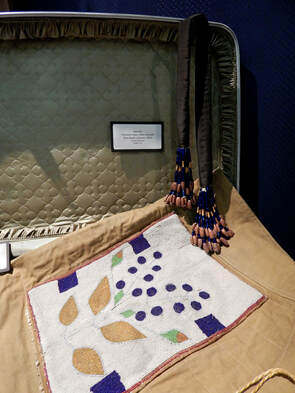New Ways of Making, New Materials, Same Tradition
 Beaded apron made of canvas made by Ina Faustino, displayed with hair ties with glass beads and pinenuts.
Beaded apron made of canvas made by Ina Faustino, displayed with hair ties with glass beads and pinenuts.
With access to different tools and materials indigenous regalia makers had wide open access to create these same traditional forms but in the materials that were at hand.
This dress was purchased from Ina Faustino, a Yurok maker, in 1965. Some pieces had been removed by Ina prior to its purchase. The canvas fabric was sturdy and was what was on hand. The glass beadwork has a leather backing, potentially cut from a purse or pouch that wasn’t needed any longer. The fringed leather at the bottom of the apron has a pattern of yellow and green throughout, potentially a found leather patch that was cut for fringe. Other sewn beadwork can be seen throughout the apron. The brass bells are there to make the lovely sounds that abalone, clamshells or deer dewclaws usually are present for.
This dress was purchased from Ina Faustino, a Yurok maker, in 1965. Some pieces had been removed by Ina prior to its purchase. The canvas fabric was sturdy and was what was on hand. The glass beadwork has a leather backing, potentially cut from a purse or pouch that wasn’t needed any longer. The fringed leather at the bottom of the apron has a pattern of yellow and green throughout, potentially a found leather patch that was cut for fringe. Other sewn beadwork can be seen throughout the apron. The brass bells are there to make the lovely sounds that abalone, clamshells or deer dewclaws usually are present for.
|
The other skirt here, made by an unknown maker, has obsidian shards as the sound element and paint for other decorative elements. Sadly, this dress came into the museum with no matching apron.
Other dresses from this time also incorporate intensive decorative elements with non-traditional design work such as the photo of the dress worn by Harriet Campbell with the star shapes done with Juniper Berries. |
|
